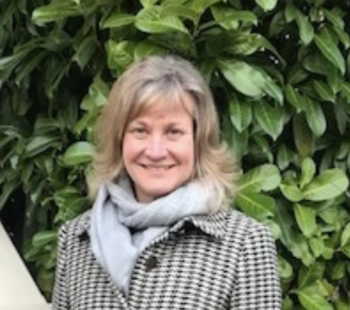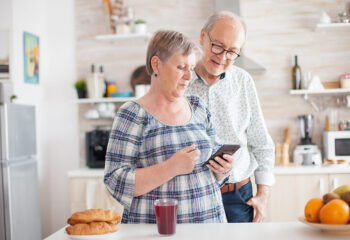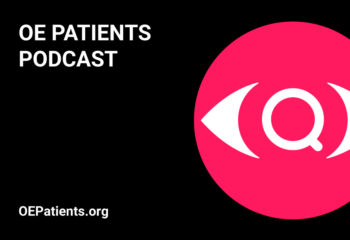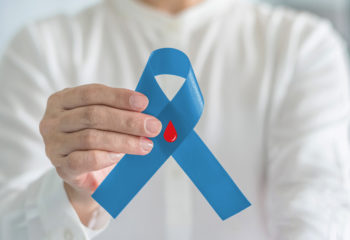Carol Yaple
CMAJ March 07, 2022 194 (9) E343-E344; DOI: https://doi.org/10.1503/cmaj.211492

The light was changing from amber to red when I turned left onto Main Street. My stepdaughter and I were on our way to a workout on a rainy Saturday morning. From the passenger seat of my trusty Subaru, she screamed — at what, I did not know.
Although we made it through the intersection without hitting an oncoming car that I did not see, our hearts were racing before we hit the gym. On the way home, I wondered about the car’s fitness, but the sudden mechanical failure turned out to be mine.
A few days later, my eye doctor stopped examining me, picked up his desk phone and speed-dialled the head of ophthalmology at the university. “There’s someone you must see right away,” he said.
On Dec. 1, 2011, I received a diagnosis of Stargardt disease, an inherited retinal disorder that affects central vision. Genetic testing showed that my mother carried the mutation, and my father contributed a common variant. One in 10,000 are afflicted with this rare condition, which often presents in childhood. I was lucky to have reached the age of 50 before I had to give up my keys. But I was in shock.
Since the first day behind the wheel of my father’s Ford truck when I was 14, I knew that driving would be my portal to other worlds. He wanted me to gain skills early and comprehensively. What better way than in the old ’48, with its manual transmission and well-worn body? With an enormous shift on the column and a clutch the size of a discus, it took all my strength to wrestle the gears, and of course my timing was poor.
I stalled often at first, while my father sighed and whistled “I Can’t Get Started.” On a dozen springtime Saturday mornings, I practised in the flat, empty pasture at my grandfather’s farm in rural Illinois. After finally finding the rhythm from first to second and then to third gear, it was time to advance to reverse. “If you need to back up, it’s hard to see where you’re going,” my father — who had been a soldier and a prisoner of war — said with unusual gravity. “You need to feel it.”
My father was resilient in this gear. This trait was my genetic inheritance from him, and a defining one, as I would come to appreciate after my diagnosis.
Once I mastered reverse in the hulking Ford, I drove my own car with confidence and what I might call desire. In the Midwest, roads are long and straight, with great distances between things. I wanted to feel the pedal under my foot, getting me to a new place under my own power.
That feeling persisted throughout my life. Working as a classical music agent, I once sped 200 km/hr in a Mercedes sedan through the night in the Swiss Alps to deliver a cargo of artists to a gig on time. The independence I felt whenever I turned on the ignition filled my whole body with energy and a taste of freedom.
“Seeing is believing,” the saying goes. What could “not seeing” mean for someone who loved driving as much as I did?
Blindness is a simple, unemotional word for most people — either a descriptor, as in “blind audition,” or, more often, a metaphor, as in “love is blind.” When sight loss actually happens to you, “blindness” becomes a full-body garment, custom made to conform with every contour of your inner and outer frame. It inflects you in a way that is incomprehensible to the sighted world as it influences your movements and interactions. How do you respond to your beloved if you cannot see his face? How do you, as an English major, cope with no longer being able to read? And how do you make sense of your changing self? No other sensory deprivation is so personal and laden with mystery. No one says “hearing is believing” or “smelling is believing.” No, only seeing is believing. Not seeing must be believing something else.
Getting to that something else now occupies the second half of my life in a way that, like the other car at the Main Street intersection, I couldn’t see coming. Like becoming aware of unconscious beliefs, it is a matter of bringing to light that which is not visible. This takes courage and imagination, but after the initial shock I have become aware of hidden resources to be tapped. Over time I have found that the sense of loss and vulnerability brought on by decreased independence can lead to a heightened appreciation for new ways of connecting to others and the world.
John M. Hull, a university professor of religious education who was blind, put it this way: “Should I begin to think of myself as a person disabled by a defect but empowered by a capacity?”
Hull spoke the question into a cassette tape recorder, his only means of writing in 1986. His book, On Sight and Insight, is a transformational account of vision loss. It helped me reframe the experience and develop creative and resourceful strategies to maintain relationships and work. The concept of a new-found capacity requires both inner and outer efforts. For me, this has involved everything from analyzing startling dream imagery, to memorizing regularly travelled routes and landmarks, to attuning my musical ear to pick up nuances in people’s voices and modulating my own in response.
Above all, acquiring skills in assistive technology has been like taking that pasture-driving course all over again. It is a matter of putting fear aside and practising a new transmission. Today there is a virtual showroom of “vehicles” used by people who are blind or partially sighted. Smartphone technology and screen readers now allow for a dazzling variety of applications, in which auditory information is activated by touch and thus provides access to written material at a terrific pace. I can shift through these gears at speed, and if I wander into a blind alley, there are keystrokes for reverse. Reading is well within reach.
Everything speaks now — Alexa, ovens, doorbells. It is no longer stigmatizing to walk around talking to yourself on the street or having your phone talk to you. This is now normal. The game-changing remedy for being blind or partially sighted — “accessibility” — is an accepted gear for the general population. This being the case, never again shall the words “nothing can be done” be used by any eye-care professional when surgical procedures or drug therapies may not be available. Much can be done, and the delivery system — already preloaded in “Settings”— is likely right there in the pockets of both the patient and the practitioner. It takes only a willingness and curiosity on the side of both parties to engage in this exploration of vision rehabilitation. This is the best time in human history to lose sight because patients now have another way to be independent.
I feel fortunate to have received guidance at a vision rehabilitation clinic, as well as services from the CNIB Foundation and a support group established by the Foundation Fighting Blindness. Every patient should be so lucky, but many suffer silently when this life-changing transition is not fully appreciated or addressed by physicians. Early guidance and referrals can create a road map to vision loss that is not a dead end but instead offers promising pathways.
Professor Hull coined a phrase that speaks to me and may resonate with other patients who experience sight loss: “whole-body seer.” As reliance on other senses increases, awareness of the whole body is enhanced. Hull writes, “A whole-body seer is someone in whom the specialist function of sight is now delivered upon the whole body and no longer specialized in a particular organ.”
Such a concentrated state of being may offer as heightened a sensation as driving. Indeed, I have noticed increased awareness and pleasure in all kinds of weather, and a deep desire for nature. With support, I have been able to accept and explore the complexities and the progression of my low-vision condition. I have not been tempted to get behind the wheel again. The day I unwittingly risked my stepdaughter’s life — and my own — shut that door for good. But I’m no longer experiencing the situation as demanding a shift into reverse. I’ve picked up a new set of keys to unlock this new life of mine and am finding my way to somewhere else.
Footnotes
- This article has been peer reviewed.
- This is a true story.
This is an Open Access article distributed in accordance with the terms of the Creative Commons Attribution (CC BY-NC-ND 4.0) license, which permits use, distribution and reproduction in any medium, provided that the original publication is properly cited, the use is noncommercial (i.e., research or educational use), and no modifications or adaptations are made. See: https://creativecommons.org/licenses/by-nc-nd/4.0/
Reference
- 1 ↵Hull JM. On sight and insight: A journey into the world of blindness. London: Oneworld Publications; 1997.Google Scholar







